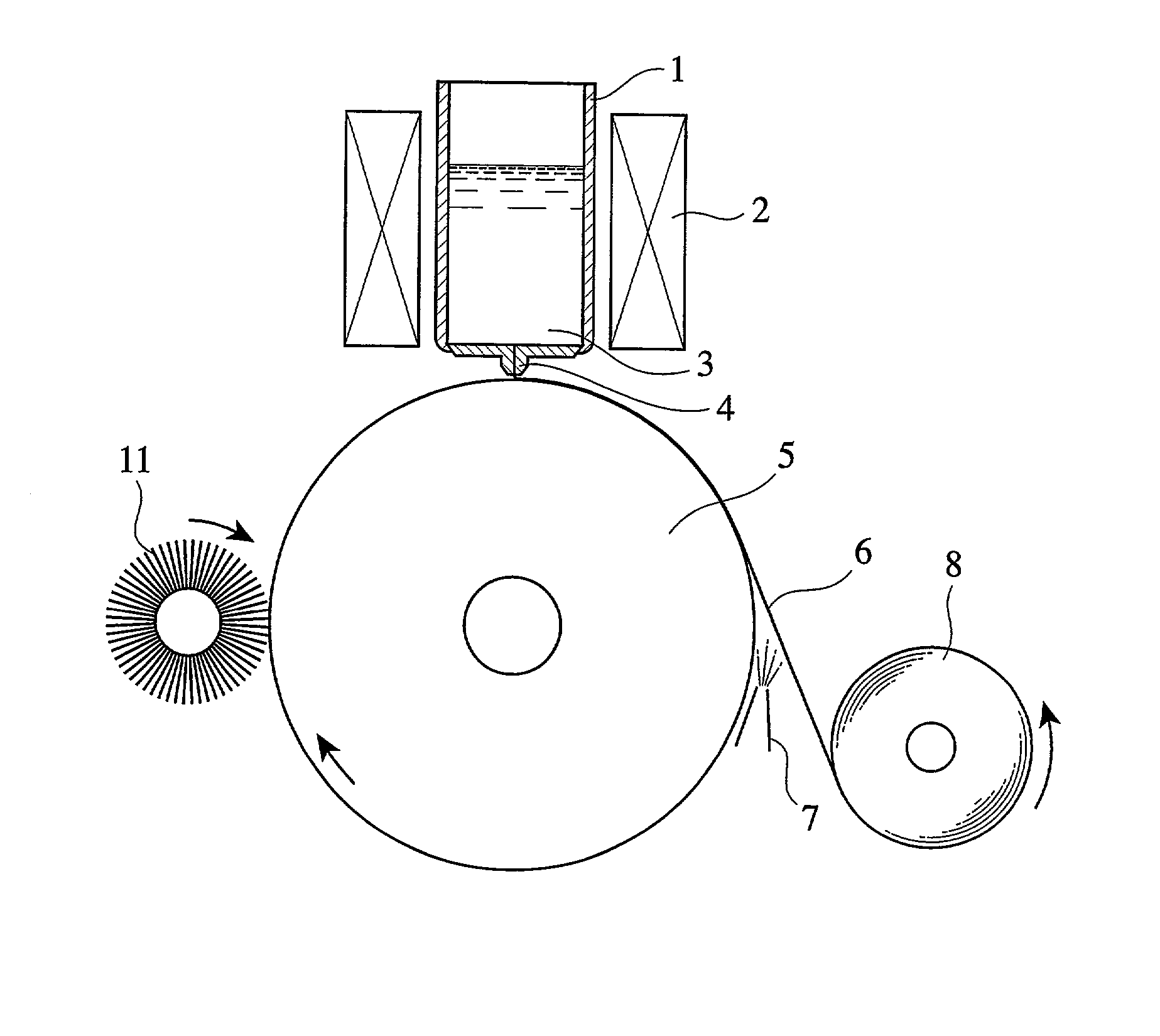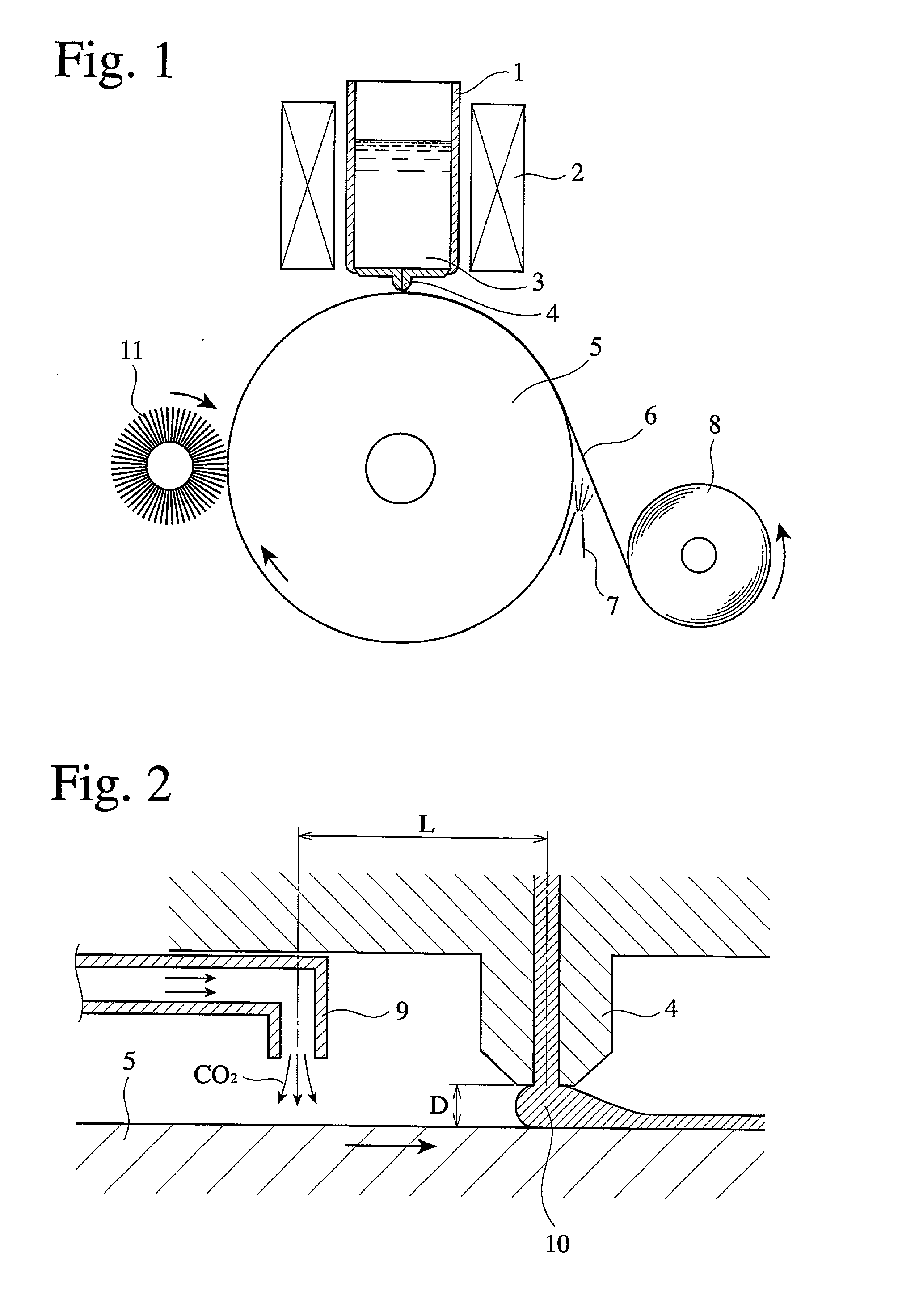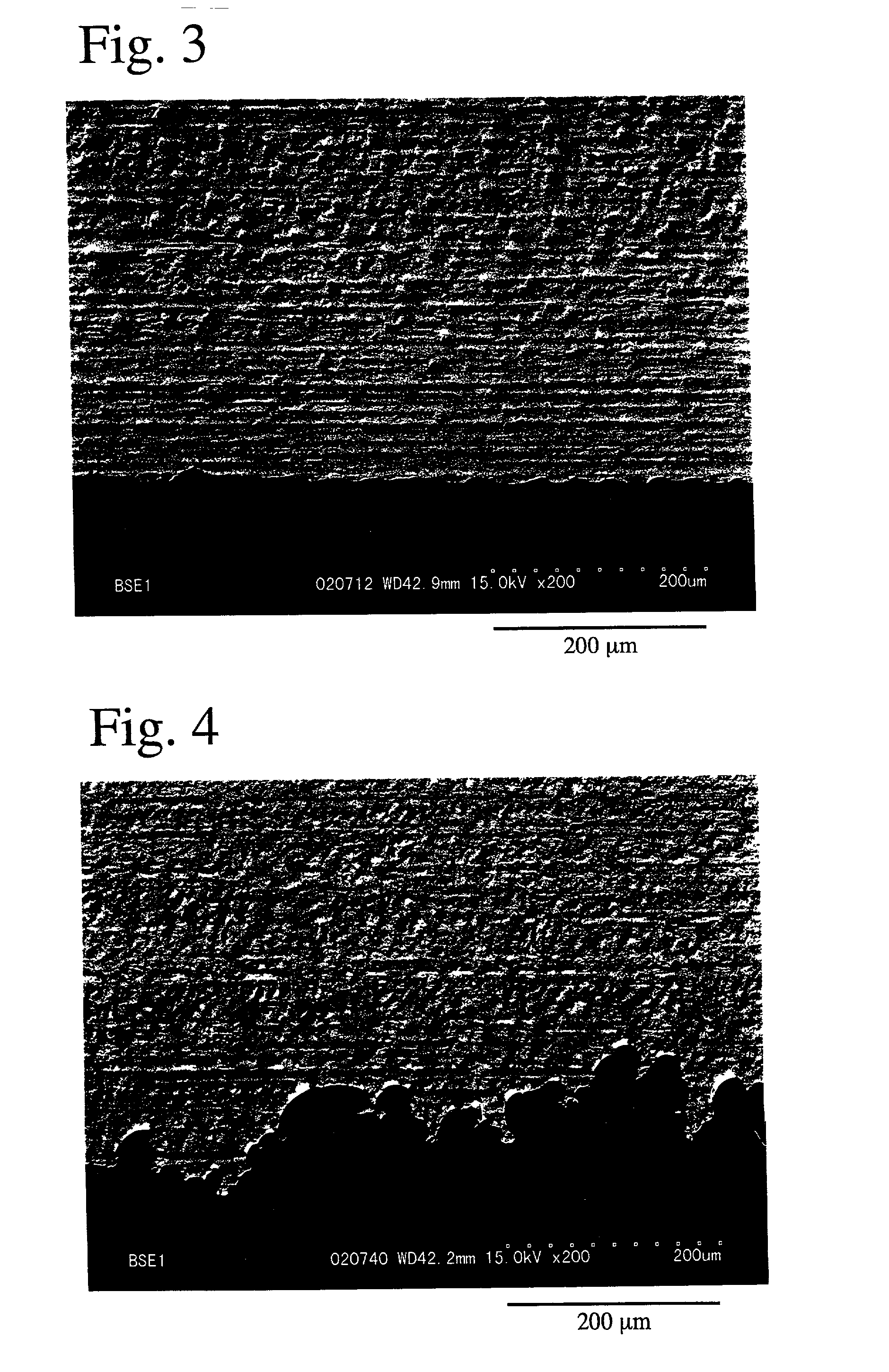Method for producing amorphous alloy ribbon, and method for producing nano-crystalline alloy ribbon with same
a technology of amorphous alloy ribbon and nano-crystalline alloy, which is applied in the field of producing amorphous alloy ribbon, and the method of producing nano-crystalline alloy ribbon with same, can solve the problems of new serrated irregular shape in the edge portion, extreme handling difficulty, and embrittlement and crystallization of formed amorphous alloy ribbons, and achieve excellent edge shapes and improved surface conditions.
- Summary
- Abstract
- Description
- Claims
- Application Information
AI Technical Summary
Benefits of technology
Problems solved by technology
Method used
Image
Examples
examples 1 and 2
, COMPARATIVE EXAMPLES 1-4
[0079] Production and Evaluation of Amorphous Alloy Ribbon
[0080] An ingot of an Fe-based alloy having a composition of Cu.sub.1Nb.sub.2.5Si.sub.13.5B.sub.7Fe.sub.bal. by atomic % was introduced into a crucible 1 shown in FIG. 1, and melted by induction heating by a high-frequency coil 2. The resultant alloy melt 3 was ejected onto a cooling roll 5 made of a Cu--Be alloy and rapidly quenched under the conditions shown in Table 1 below, to form an amorphous alloy ribbon 6 of EXAMPLE 1 having a width of 30 mm and a thickness of 19 .mu.m.
1TABLE 1 Casting Conditions Temperature of melt 3 1,350.degree. C. Peripheral speed of cooling roll 5 27 m / second Distance D between tip end of 120 .mu.m melt-ejecting nozzle 4 and cooling roll 5 Position of CO.sub.2 gas-blowing nozzle On upstream side of melt-ejecting 9 nozzle 4 with CO.sub.2 gas blown in radial direction of cooling roll 5 (see FIG. 2) Flow rate of CO.sub.2 gas 30 L / minute Start of supplying CO.sub.2 gas After...
examples 3 and 4
, COMPARATIVE EXAMPLES 5-8
[0092] An ingot of an alloy having a composition of 9 atomic % of Si W and 13 atomic % of B, the balance being substantially Fe, was introduced into a crucible 1 shown in FIG. 1 and melted by induction heating by a high-frequency coil 2. The resultant melt 3 was ejected onto the cooling roll 5 made of a Cu--Cr alloy and rapidly quenched to produce an amorphous alloy ribbon 6 having a width of 40 mm and a thickness of 20 .mu.m under the conditions shown in Table 4.
4TABLE 4 Casting Conditions Temperature of melt 3 1,300.degree. C. Peripheral speed of cooling roll 5 30 m / second Distance D between tip end of 180 .mu.m melt-ejecting nozzle 4 and cooling roll 5 Position of CO.sub.2 gas-blowing nozzle On upstream side of melt-ejecting 9 nozzle 4 with CO.sub.2 gas blown in radial direction of cooling roll 5 (see FIG. 2) Flow rate of CO.sub.2 gas 40 L / minute Start of supplying CO.sub.2 gas After 5 seconds from start of casting Grinding of cooling roll 5 Grinding at ...
examples 5-7
[0099] Each ingot of alloys having compositions shown in Table 8 was introduced into a crucible 1 shown in FIG. 1, and melted by induction heating by a high-frequency coil 2. Each of the resultant alloy melts 3 was ejected onto a cooling roll 5 made of a Cu--Be alloy and rapidly quenched to produce an amorphous alloy ribbon 6 having a width of 30 mm and a thickness of 22 .mu.m under the conditions shown in Table 7. The casting of the amorphous alloy ribbon was repeated 10 times. In the production process of the ribbon with a CO.sub.2 gas supplied, the grinding of the cooling roll 5 was carried out by rotating a brush 11 in the same direction as the cooling roll 5. The winding method of the resultant ribbon was the same as in EXAMPLE 1.
7TABLE 7 Casting Conditions Temperature of melt 3 1,350.degree. C. Peripheral speed of cooling roll 5 27 m / second Distance D between tip end of 120 .mu.m melt-ejecting nozzle 4 and cooling roll 5 Position of CO.sub.2 gas-blowing nozzle On upstream side...
PUM
| Property | Measurement | Unit |
|---|---|---|
| Angle | aaaaa | aaaaa |
| Angle | aaaaa | aaaaa |
| Percent by atom | aaaaa | aaaaa |
Abstract
Description
Claims
Application Information
 Login to View More
Login to View More - R&D
- Intellectual Property
- Life Sciences
- Materials
- Tech Scout
- Unparalleled Data Quality
- Higher Quality Content
- 60% Fewer Hallucinations
Browse by: Latest US Patents, China's latest patents, Technical Efficacy Thesaurus, Application Domain, Technology Topic, Popular Technical Reports.
© 2025 PatSnap. All rights reserved.Legal|Privacy policy|Modern Slavery Act Transparency Statement|Sitemap|About US| Contact US: help@patsnap.com



